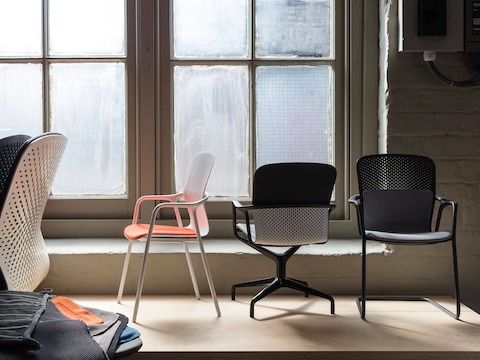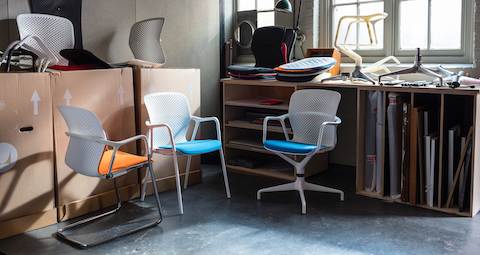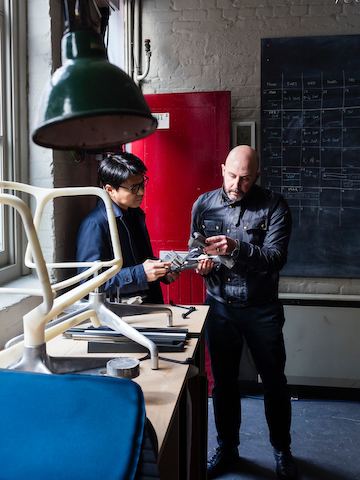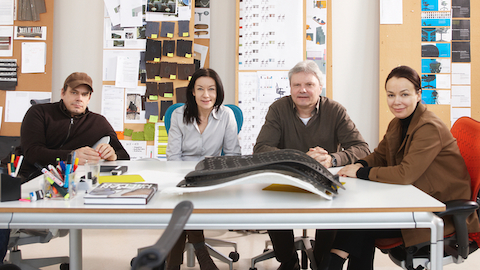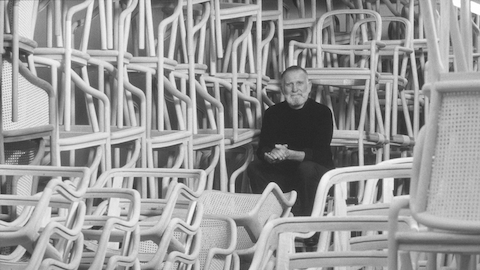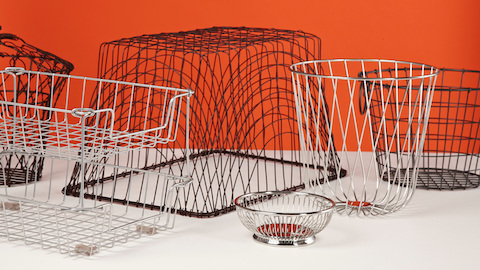Residing down a small street in an unsuspecting corner of south London is the studio of design agency forpeople. The studio was established in 2004 by—you guessed it—four people who originally met at Ford Motor Company’s global creative studio Ingeni. Fast forward to today and forpeople’s 100-strong team is responsible for a wide and varied design output across multiple sectors, from communications for Coca-Cola and musical instruments for Yamaha, to luxury gadgets for Dunhill and the total airline experience for British Airways.
There is a simple philosophy that lies behind the studio’s complex output. According to co-founder Richard Stevens, their designs start with careful observation of how people “feel, think and do.” They encourage their team to always design with the end user at the forefront of their minds—not only to provide further corroboration of their studio’s name, but also products, services and experiences that solve real problems.
With the new Keyn Chair Group, the studio brought their empathic approach to Herman Miller. Nestled amid a range of early prototypes and samples from the extensive development process, forpeople’s Richard Stevens and partner Joohee Lee sat down with us and Nick Savage, Herman Miller’s Director of Research, Design and Development, to discuss the chairs.
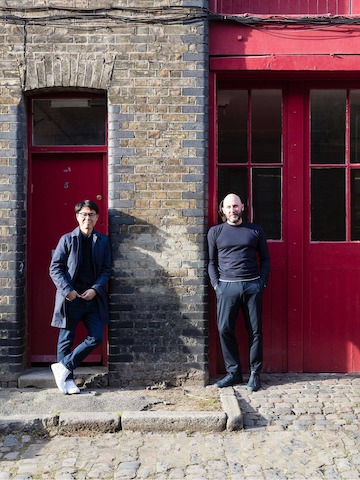
Joohee Lee and Richard Stevens outside of the south London studio of design agency forpeople.
“The solution we’ve come up with looks pretty simple but over the years there have been literally hundreds and hundreds of tweaks—to the armrest positions, the shell shape, you name it…”
-Richard Stevens, forpeople
How did this project come about with Herman Miller?
Richard Stevens: As a studio, we work across consumer electronics, automotive, aviation, musical instruments, hospitality…loads of different sectors. Internally, we started exploring what the next natural progression of our understanding of people in other markets was. We design a lot of furniture for products on the move, namely aviation and automotive, so we thought, ‘Why don’t we talk to Herman Miller about designing a chair?’ Following our initial introduction, we worked with Herman Miller on a research project to observe the workplace. In May 2011, we were asked to work on a chair project and here we are, five years later, finally launching it.
Tell us about the working methods you practice in your studio and how they might differ from other design consultancies.
RS: The premise of forpeople has always been about understanding people in their everyday lives—and using that knowledge to drive our design. Everything we do as a studio is about keeping the end user in mind. Often when you’re embroiled in the process of developing a product or service, designers often lose sight of why they’re being asked to do something. We ask our team not to think like designers but to think like people first.
We talk about our studio as being made up of individuals with many different talents looking collectively at problems to solve. We tell stories that resonate at a business level but also compel people emotionally, and we’re also good at building experiences. We never design one thing in isolation; we design it with a clear understanding of how it impacts everything that goes on around it.
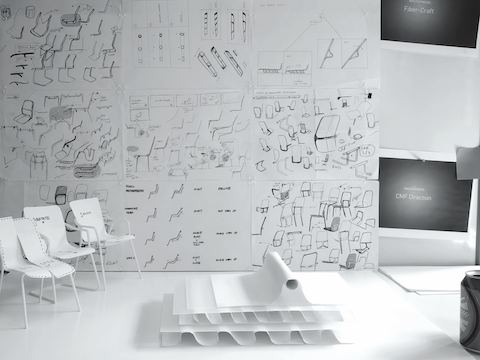
White card models and sketches were used to communicate initial ideas for the kinematic movement within the Keyn chair.
What were the initial stages in your collaboration?
Nick Savage: This project started, as they all do, with a design brief, and then an exploration phase, and that’s when we look at lots of different ideas and whittle those down to those that we’re interested in.
We bring relatively few people in during the exploration phase, which typically lasts six to nine months so that it doesn’t get bogged down by expectations of cost, forecasts, sales and operational constraints. It’s a very collaborative period and there’s normally lots of shouting and debating!
At the end of this phase, we present a development proposal; this is a request to the business to support our ongoing investment through the development phase, which is when we also expand the team.
What were some of the questions you were trying to answer during the exploration phase?
RS: We asked ourselves, how do we design for Herman Miller and where do we fit in their mix? How do we design a product family? We explored their existing product family and proposed ideas with like-minded DNA.
NS: We evolved the original brief, which initially didn’t have any requirement for movement and kinematics. We added that feature off the back of a scientific piece of research we did that measured the physical responses of individuals in many different meeting settings, undertaking many different tasks.
RS: Yes, we worked hard on postural well-being. We gained valuable insight around the observation of ‘boring meeting syndrome’, which is something that hadn’t been addressed. What happens to people when they’re seated for a long time? How do their concentration levels affect their seated position and how can the chair best aid these changes? This research informed the development of the moving seat and back—a totally new innovation.
We wanted the chair to be upright for when someone is working at a meeting on a laptop but as they get bored, we developed the kinematics so that they can slide into the seat and lean back, which is what they’ll do naturally. It’s about opening up the core—it’s that simple.

The aim was to create a crafted feel in the polymer shell and cradle components through a combination of textured and polished features. Each material junction and intersection was considered and crafted to deliver a product that epitomizes attention to detail.
Over the course of five years, you must have encountered some distinct challenges. What were some of those?
RS: The initial challenge was to design a chair family and make it flexible in terms of its ability to be premium or to be contemporary. It’s very difficult to design a group of chairs that have all of the different base requirements that all of the different people around the world need in different environments—and even more so, one that would complement every other Herman Miller chair in the portfolio.
The solution we’ve come up with looks pretty simple, but over the years there have been literally hundreds and hundreds of tweaks—to the armrest positions, the shell shape, you name it.
The thing that I was most worried about not being able to deliver was the seating pad: the challenge was how to manufacture a pad that has to move with the chair, made more difficult by the fact that it’s made up of three different component parts. Also, the pad can’t be impacted when you stack it. Furthermore, the task of making it has to be repeatable by any production operator anywhere in the world. It was a new world for Herman Miller and for the industry as it hadn’t ever been done before.
Joohee Lee: For me, the challenge was the seat shell and overcoming the complicated engineering to enable material flexibility for its seemingly simple sliding motion. This was also where we could express the Herman Miller DNA within the layout, the geometry and the pattern. We studied it a lot, developing new software that could create any pattern without a very time-consuming manual process of digital mapping.
RS: As we learnt more about the workings of Herman Miller, we also learnt about how you develop something to meet a particular price. A lot of furniture businesses go out of their way to develop what a designer wants, and they come out with lots of beautiful products that are so expensive that the end retail cost is actually prohibitive. So for us, the other challenging part of this project was that each component had a cost tipping point; if we exceeded that, it would be gone. It was really strict!
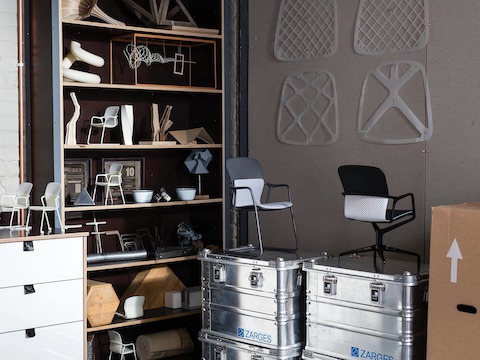
Scale models and prototype parts displayed in forpeople’s studio help tell the story of the design process.
Tell us about the collaborative relationship between Herman Miller and you as an external design partner.
RS: This project has been completely collaborative. If you don’t understand where your collaborators are coming from and you don’t go out of your way to really find out their parameters, then you can’t expect to challenge it or come up with an alternative solution. Of course, you have to pick your battles on projects and we would always try to find ways to circumnavigate a problem and then come back to it.
NS: There should be a healthy tension between the development engineers and the design partners—and that’s actually part of our strategy. We really beat ourselves up about getting to the best solution to solve a problem. We expect the designers to push us, and we push them. With forpeople, I think we achieved that constructive balance.
RS: Everyone had a singular goal. We knew throughout the development that everyone was covering every detail and ultimately supporting each other.
What have been some of the most satisfying moments in the project?
NS: The development of a project like this is like a groundswell: it just gets better and better. As engineers, seeing the first parts from the tooling is the most exciting.
JL: Even though it’s an industrially manufactured product, the depth of craftsmanship in the development has been amazing. This chair has taken five years and as a product designer, that’s actually a luxury. We’ve made sure every single part works exactly as it should. I think we all can look at this chair and know it’s the best it can be.
RS: All of the details are truly considered. Everything is there for a reason and there’s no frivolity in the chair. A lot of people who sit on it don’t realise it moves, and then you see the look on their face when it does. That’s one of the biggest wins on this project for me.
NS: It’s a testament to this project that we’re building on what we achieved, and have already started our next exploration with forpeople.
